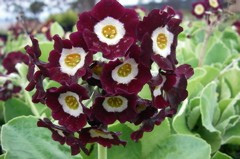
Dierama igneum
A delicate little species with distinctly different flowers from the usual dierama form. These are open bells like a campanula, deep pink in colour, and appear in mid to late summer.


We have grown seedlings of Alice Haysom, from which we have selected the best plants and increased from division. Best in well drained conditions in a pot or the rock garden.
We have grown seedlings of Alice Haysom, from which we have selected the best plants and increased from division. Best in well drained conditions in a pot or the rock garden.
Data sheet
A delicate little species with distinctly different flowers from the usual dierama form. These are open bells like a campanula, deep pink in colour, and appear in mid to late summer.
Choice evergreen Iris from Greece and Turkey with blue flowers like Iris reticulata. Our stock plants grow well in a sunny south-facing rockgarden.
Spectacular summer flowering salvia for bedding and foreground plantings, frost hardy and perennial. Cut to ground in winter.
I love helianthemums for their abundant flowering, and superb ground covering abilities in poor growing conditions. We found this as a chance seedling and thought it was worth naming and propagating.
Attractive multicoloured variety, which starts off as lime green and cream then ages to pink or pale blue depending on soil pH. Morning sun only, best in part shade with good drainage.
Pure white flowers over fresh green fern-like foliage in spring. Useful beneath trees in semi-shade.
Prolific low mounding erigeron with long flowering habit, useful for many planting applications. Looks great as a path edging or border mass planting or fill under roses, and needs minimal care or water.
A recent release from our trial beds, begins as brighter musk pink then fades to soft pink then eventually cream, subtle and lovely and multicoloured tones as the flowers age. Easily cultivated like other yarrows in full sun.
A wild Paeonia from the Caucasus from Ukraine to Romania with deep tomato red flowers and finely dissected foliage. This is a dwarf species which prefers fertile but drained conditions, and needs to dry off in summer after the growing period. A rare treasure.
A lower compact form that is brilliant for massed foreground plantings at 40cm high. These cheerful flowers combine well with other summer flowering perennials like echinacea, sedums, salvias, and perennial grasses. Ideal in coastal and Mediterranean climates.
Garden cross between Helleborus sternii and H. niger, these are division grown plants from our collection. Few only.
Lovely variety with flower spikes in peach and apricot tones, like the colours of old fashioned roses. Clumping habit and long flowering.
Resembles Euphorbia martinii in flowering, having a reddish brown spot within the green bract. Closer in habit to Euphorbia wulfennii, this a more dependable garden plant, proving itself as long lived in a variety of dry situations.
Improved strain from Germany with multiple stems and darker blue flowers than the species. Good for cutting and drying.
Classical double white border carnation, with good fragrance and vigourous growth. Long lasting plant for rock garden or border. Cut back occasionally.
Low mounding plant with silvery finely cut foliage and white daisies. Native to Sicily, extremely drought tolerant avoid over watering and wet areas. Cut back occasionally after flowering.

We have grown seedlings of Alice Haysom, from which we have selected the best plants and increased from division. Best in well drained conditions in a pot or the rock garden.